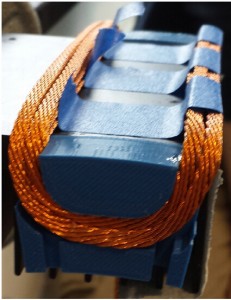AC Losses in a 1 MW PM Electric Machine Using High-Frequency Air-Core Armature Windings
MS student Jonathan Martin with advisor K. Haran
The highest power density megawatt-class electrical machines have been developed on the order of 9.16 kW/kg using cryogenic high-temperature superconductor windings. To translate the same class of electric machines to aerospace applications using non-cryogenic technology, the electrical loading per unit weight must be maximized. Additionally, these applications must be capable of the high frequencies being sought for high-speed, high power density machines.
The key feature will be the high-frequency air-core armature winding mounted on a toothless stator yoke. Given the objective of achieving the highest power density possible, these high-frequency currents pose a challenge to the motor design since high ac losses are a trade-off for operating in high-frequency spectrums. The most prominent sources of such losses will be due to skin and proximity effects in the copper strands, which will be mitigated by utilizing Litz wire for the armature winding. Experiments have been carried out on ac losses using finite element machine models to readily optimize the proposed hardware design. Such optimizations include individual strand size, copper fill factor, and overall winding geometry. In addition to finite element analysis (FEA), several bench tests are in process. These serve two purposes: to validate the FEA model results and address the feasibility of manufacturing the machine design. For instance, Figure 15 shows an example of a single-phase armature winding utilizing a 3-D printed winding frame (shown in blue) with Litz wire.
This material was presented recently at the 2015 Electrical Manufacturing & Coil Winding Expo in Milwaukee, WI. The research is supported by NASA grant NASA NNX14AL79A and the Grainger Center for Electric Machinery and Electromechanics.
